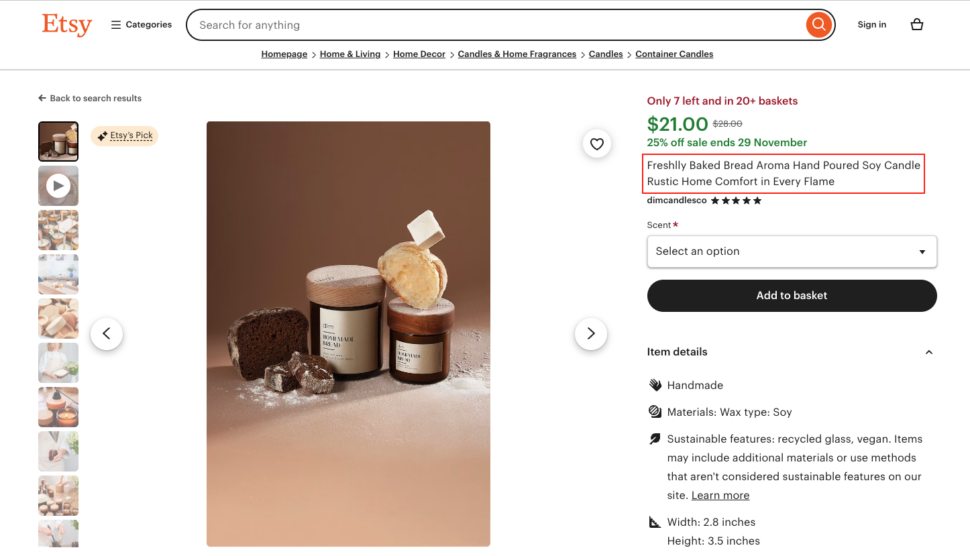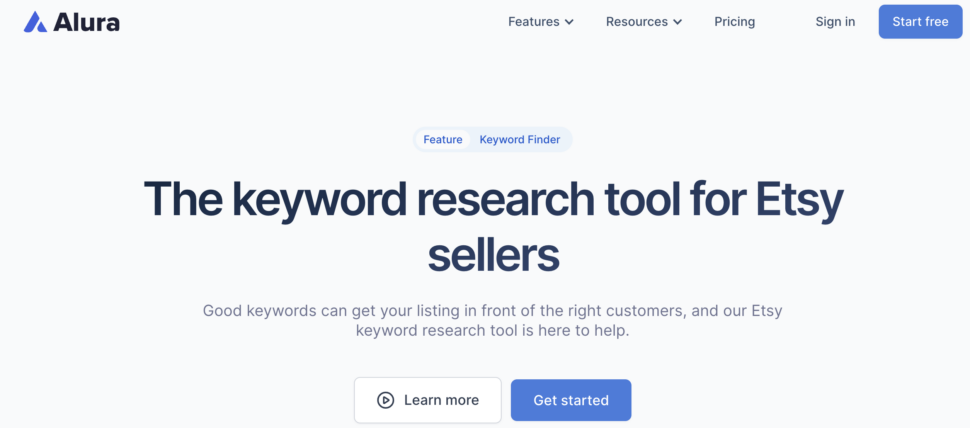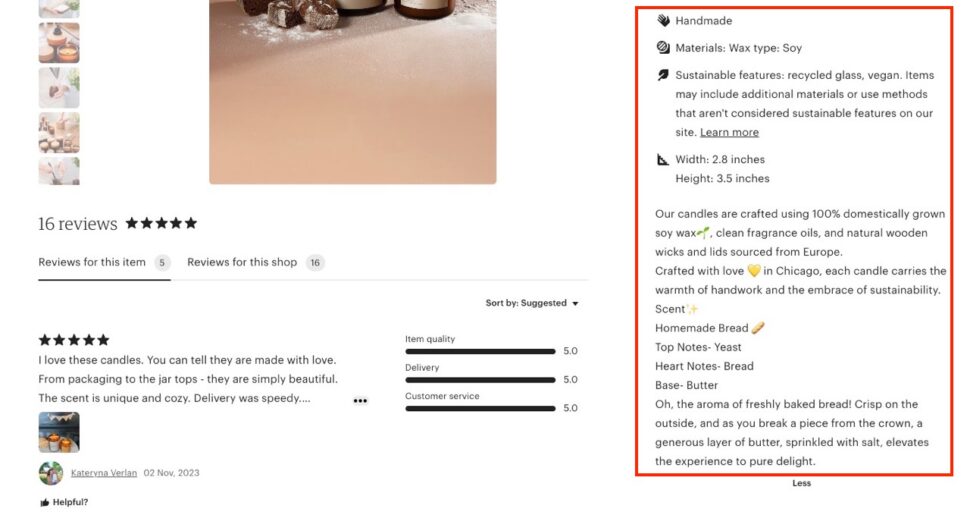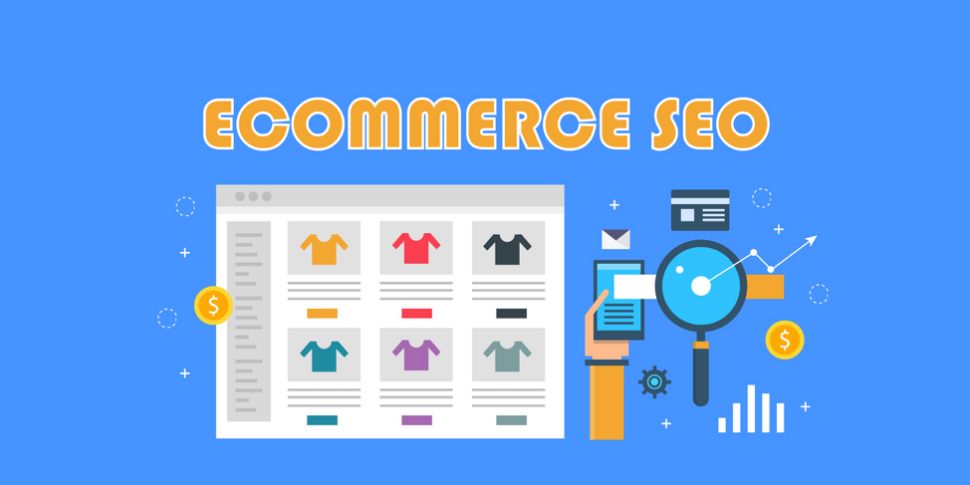The higher up your Etsy shop appears in search engine results, the more traffic you get, which can ultimately lead to more sales and more positive reviews from customers. That’s the nature of search engine optimization (SEO): improving your search ranking to improve your business.
But when it comes to SEO, Etsy sellers have their own particular set of guidelines compared to other e-commerce platforms.
For one thing, Etsy’s search algorithm behaves differently than those of Google or Amazon, so you have to modify your SEO strategy accordingly. But it goes deeper than that: shoppers on Etsy might use different search terms than shoppers on other platforms like Shopify. Etsy store pages are also set up with unique opportunities for including relevant keywords, unlike other e-commerce marketplaces.
In this guide, we share seven Etsy SEO tips to boost your product listings and store page on both Etsy and Google search results pages. Keep these tips in mind when you write your item descriptions to get your Etsy products on the first page for shoppers’ search queries.
1. Choose your shop title and listing titles carefully
When it comes to Etsy SEO, your shop name and listing page title carry extra weight. That makes them the ideal place to use keywords, especially the most relevant keywords.
However, the top priority of your product title and shop name is to let shoppers know what the product is and what kind of store you are. You never want to confuse shoppers with an overly clever name or by keyword stuffing your item title. Choose a simple and direct product title, but include one or two specific keywords that fit in naturally.
The goal here is to get an exact match with search queries for individual products, but also to tell potential buyers what you’re selling if they come upon your Etsy listings indirectly. If you’re not sure what to put as your shop name or product title, you can use PickFu to test your business name with people who fit the criteria of your unique target customers.
2. Conduct high-quality Etsy keyword research
Success or failure in SEO is determined by whether you use the right keywords. Query matching is the goal; you want to find the specific keywords your shoppers use in search queries. This applies to your Etsy SEO strategy as well as any other search engine your customers use.
One of the best places to start is keyword research: identifying the best keywords and search terms that your potential customers use most. You can use Etsy SEO tools to gauge a keyword’s popularity and competition level, or even general SEO tools, including some of the Amazon keyword research tools we discussed earlier. These keywords will prove vital when it comes time to write your product descriptions.
3. Use keywords strategically in Etsy listings
It’s a balancing act to use keywords correctly when making new listings. On the one hand, you want to include all the right keywords so potential customers can find your products when they conduct searches. On the other hand, using too many keywords (known as “keyword stuffing”) can actually penalize you in many search rankings, including Google searches.
The solution? Use keywords strategically – place them only in the optimal spots to maximize visibility without overdoing it by keyword stuffing. The optimal spots, according to Etsy’s keyword guide, are the following:
- Categories
- Attributes
- Titles
- Listing descriptions
- Tags
Try to include the right keywords in each area, but use them sparingly in other sections. The product descriptions are a good place to add all the low-priority keywords that didn’t fit in the main areas like the product title.
4. Include long-tail keywords in Etsy tags
Etsy tags are designed specifically for search engine optimization. They give Etsy sellers an extra opportunity for search query matching for keywords that are difficult to use elsewhere, such as long-tail keywords.
Use Etsy tags to catch all the keywords you couldn’t fit elsewhere on the listing page. Each tag can hold 20 characters, which makes them a good spot for awkward long-tail keywords that are hard to naturally work into your product descriptions or item titles. It’s also a good place to use less-popular synonyms of your other keywords, such as regional phrases, alternate spellings, or slang.
Be careful not to repeat any Etsy keywords from your categories or attributes, as it’s redundant and risks keyword stuffing. Likewise, don’t bother with other languages, as Etsy adds translations automatically. Last, try to use all 13 tags available to Etsy sellers so you don’t waste any opportunities.
5. Add shop sections to improve your shop’s SEO
One of the perks for Etsy shop owners is the option to create shop sections. Etsy shop sections allow sellers to organize products into particular groups like type, recency, size, or special collections. These shop sections are great for both your Etsy ranking and listing quality because they enhance the customer experience by making it easier to find what the shopper is looking for.
As a secondary benefit, shop sections can also help with your Etsy SEO strategy. Basically, shop sections provide extra opportunities to include specific keywords – in particular, extra page titles. As mentioned above, page titles are ideal placements for the best keywords, so take full advantage of the extra slots Etsy shop sections open up.
6. Get backlinks from social media and external sites
Using backlinks, also known as “inbound links,” is not just for Etsy search engine optimization, but for all SEO. Backlinks are a popular and effective tactic used by many websites, even outside of ecommerce.
The idea is to get links to your product pages or Etsy store on external sites. These inbound links are attractive to many search algorithms, making them a great way to improve your search ranking. The easiest approach is to use social media posts, but you can also collaborate with retail bloggers or other Etsy sellers to do link exchanges — after all, they can benefit from inbound links on your sites just like you benefit from links on theirs.
7. Target Google search results as well
Unlike our other Etsy SEO tips, our final piece of advice isn’t about Etsy’s search algorithm. For true ecommerce success, you need to broaden your horizons by targeting other search engines – especially Google search.
Etsy.com is popular, sure, but not nearly as popular as Google. Chances are, many of your potential customers are going to start their shopping on Google; they may not even be aware of your Etsy store, or perhaps have never used Etsy before. You don’t want to miss out on these shoppers by limiting your SEO strategy exclusively to Etsy. In fact, you could be the one to first introduce these shoppers to Etsy.
To factor in Google searches, simply expand your keyword research. If you’re using an Etsy SEO tool, try one that includes Google search results as well. Remember that different types of people use different search queries, so the search terms used on Google may be slightly different than the ones on Etsy.
Conclusion: Think Beyond SEO
SEO gets customers in the door, but other marketing and sales efforts actually land the sale. It’s a two-part sales strategy: first you attract the customer with SEO, and then you convince them to buy.
When you’re planning your Etsy SEO strategy, remember that it’s just a means to an end. You need more than SEO alone for a successful conversion rate; you also need high-quality product photos, enticing product descriptions, wide-reaching marketing campaigns on social media, and in-demand products in general.
While it’s a lot of work to check all those boxes, PickFu can help. By offering a direct line of communication to your target audience, PickFu lets you test different variations of product photos, item titles, shop names, product descriptions, and even pricing. Respondents will tell you which version they like best, with commentary in their own words.
You can filter participants by age, gender, income, or even interests to match your target audience. PickFu offers this rare opportunity to engage directly with your shoppers and hear what they have to say about your products. Sign up for free now and see for yourself the difference PickFu makes.
Frequently Asked Questions
How do I optimize SEO on Etsy?
The best Etsy SEO strategy consists of both finding the right keywords and placing them in the best spots on your Etsy listing page. The right keywords will match the search queries your potential customers use and also describe the product with enough relevancy. The best spots on your Etsy listing page include the product title, attributes, category, Etsy tags, and the product description itself.
Where are the best SEO keywords for Etsy?
The best SEO keywords for Etsy depend on the product and your target audience. Different types of people use different search terms when shopping, so you want to do your best to match their search queries. Try using an Etsy SEO tool to reveal popular keywords with low competition.
How long does it take for Etsy SEO to work?
SEO improves with time, so the sooner you upgrade your Etsy SEO strategy the better. That said, it’s never too late to fix your problems or overhaul your search engine optimization — every search that happens from then on will benefit.









